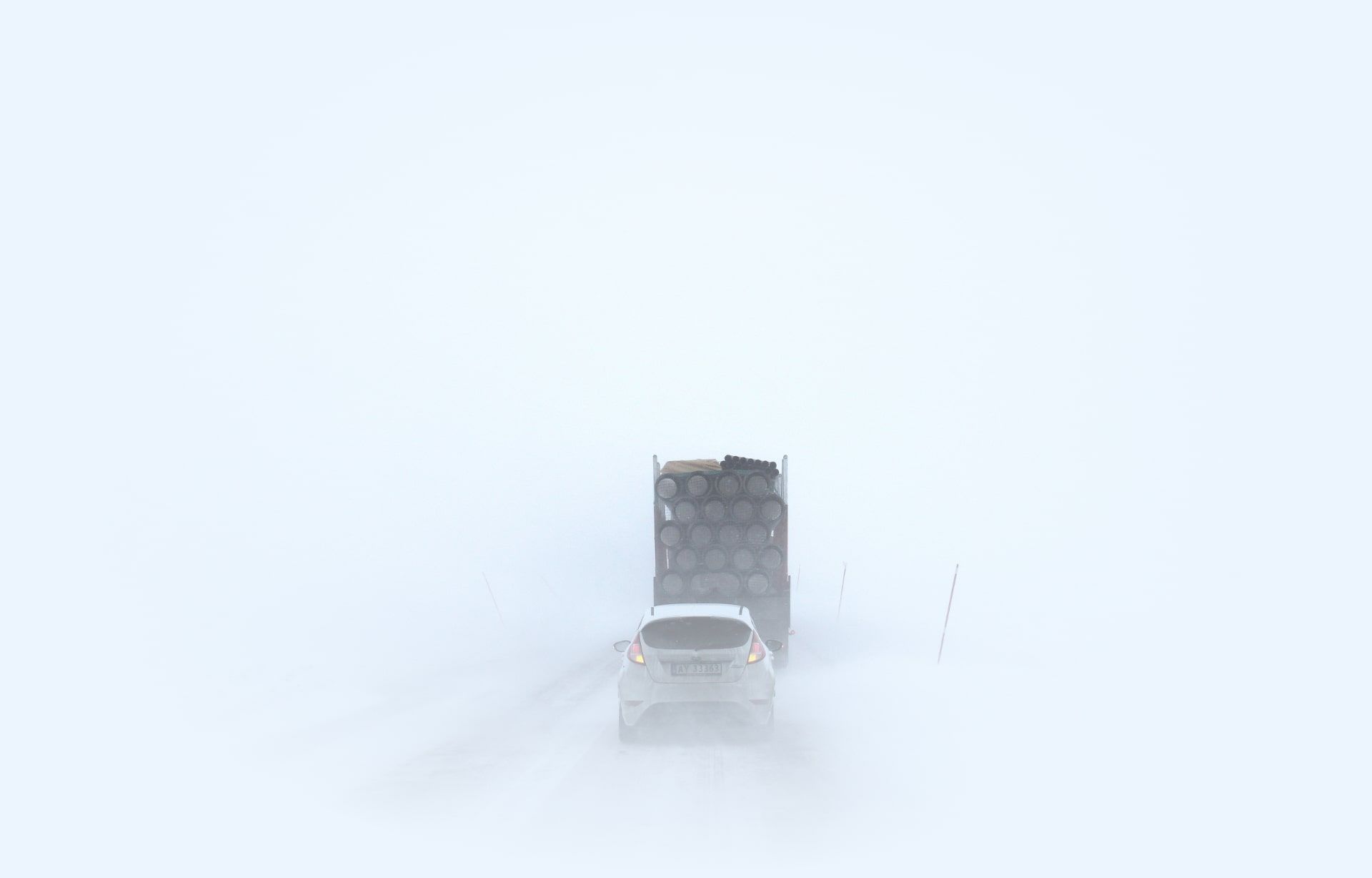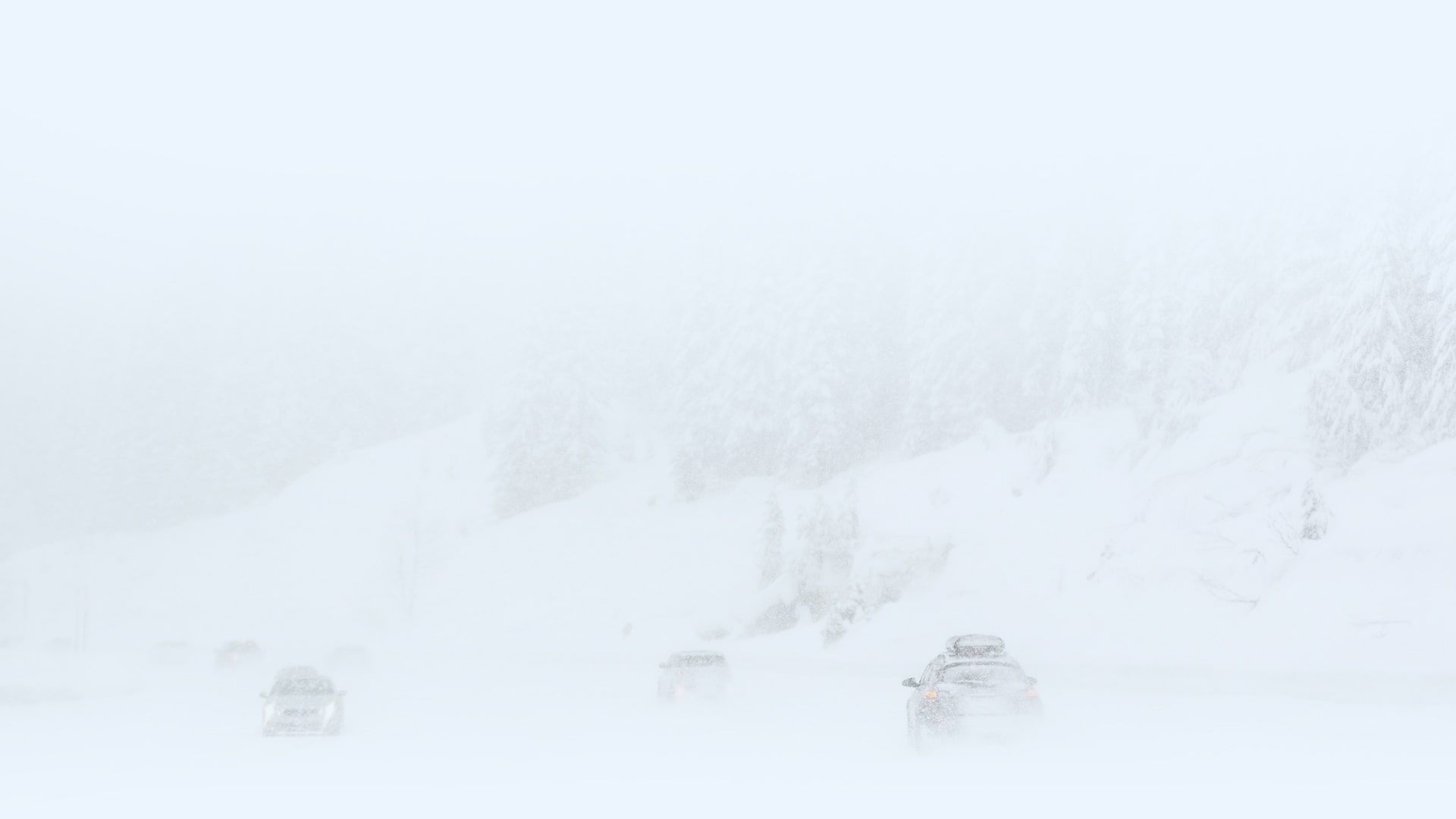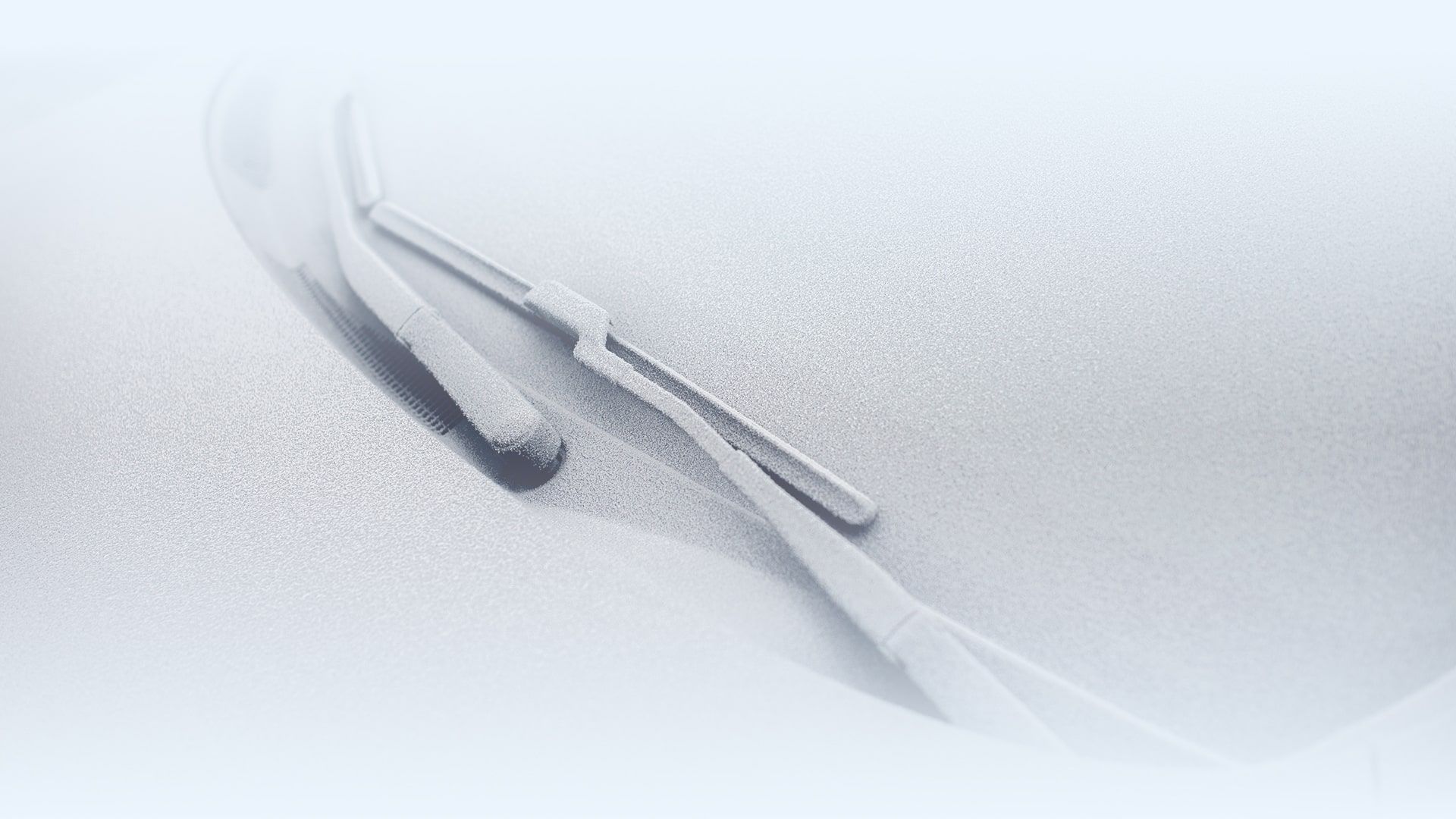
Staying Safe on UK Roads in Winter
What You Can Do

An Introduction To
Driving in Winter
Weather conditions will always affect the way we drive, and this is especially true in winter. Not only do cold temperatures mean it can take more time for your vehicle to get started, but there are a range of challenges you could encounter – sometimes on the same day.
The weather in the UK is unpredictable at the best of times, so preparation is essential. 45% of drivers don’t do any checks on their vehiclebefore winter starts, but knowing what to do and what you need could save your life.
Make sure you know how to look after your vehicle and adapt your driving, and you’re more likely to have a safe, calm journey.
Weather conditions you might encounter
The UK has a temperate oceanic climate, which means it has four distinct seasons (spring, summer, autumn, and winter), with mild temperatures, cloudy skies, and rain throughout the year.
The average winter temperature in the UKnormally sits between 2℃ and 7℃, and often drops to just below 0℃. There is little temperature variation between different regions, but the north of England, Scotland, and Wales are more likely to experience heavy rain or snow, as are mountainous areas.

Source:Met Office
Weather conditions you might encounter while driving in winter include:

Rain, Hail & Sleet

Front, Ice & Snow

Fog

Strong Winds

Winter Sun
How likely is it that the UK will get snow?
When we were younger, we might have looked forward to snow days. But snow can be disruptive to your journey when you’ve got to drive.
According to the Met Office:
The UK gets an average of 23.7 days of snowfallor sleet per year.
However, the amount that settles on the ground is a lot lower, at 15.6 days per year on average.
These numbers increase in Scotland, where they get an average of 38.1 days of snowfall or sleet.
The amount that settles on the ground goes up to a yearly average of 26.2 days.
Safety precautions in the UK
To make sure UK roads stay safe and people can still get around, the Highways Agency prepares for winter year-round with:
Tonnes of Salt
Depots
Winter Vehicles
Weather Stations
 Local authorities will grit major roadsin
preparation for ice or snow.
Local authorities will grit major roadsin
preparation for ice or snow.
Meanwhile, the Met Office gives weather warnings up to seven days in advance for rain, thunderstorms, wind, snow, lightning, ice, and fog.
There are three types of weather warning in the UK:yellow, amber, and red.

Yellow
Yellow warnings are normally issued when the weather will cause low-level impact. There could be disruption in some locations, but not all, so it’s important to check what could happen in your local area. You may need to change your route if you’re planning to drive.

Amber
Amber warnings are issued when there’s more chance of severe weather having an impact. Travel delays (including road and rail closures) and power cuts are possible, and there’s a potential risk to life and property. You’ll need to consider changing your plans and protecting your property beforehand.

Red
A red warning means dangerous weather is expected and you should take action to keep yourself and others safe (if you haven’t already). Risk to life and disruption to travel and energy supplies are all very likely. There could also be widespread damage to property and infrastructure. You need to avoid travelling unless it’s absolutely necessary and follow the advice issued by the emergency services and local authorities.
The Met Office use a matrix to show the likelihood of a forecast having an impact, as shown in the example below.
Warning Impact Matrix

Are you covered by car insurance if a red weather warning has been issued?
Yes, as long as your car is also taxedand has a valid MOT. It’s worth asking your insurer for clarification if you’re not sure. The only time an insurer may not pay out is if an accident happens due to irresponsible driving – regardless of the weather.
Before your journey
It’s tempting to head off quickly and get your journey over with, to avoid being out in the winter weather for too long. But taking time to answer a few key questions before you go will help you feel more in control.
Have you considered your health?
You are more likely to catch a cold or other illness in winter, and this can make driving dangerous.
According to the RAC, research shows that your concentration falls by more than half if you have a cold or flu, and your reaction time also slows down. The symptoms, especially sneezing, can be particularly troublesome. Drivers can travel up to 50ft with their eyes closedduring a sneeze and may lose control of their vehicle.
Both prescription and over-the-counter medicines can add to this danger by causing drowsiness. Always read the leaflet and speak to your GP if you’re unsure about any of the side effects.
The bottom line is:don’t drive if your health could affect your safety and that of others.
Do you have breakdown cover?
Most journeys will be trouble-free. But if nothing else, knowing you have adequate cover will give you peace of mind if your vehicle does break down. It also means you won’t be stranded waiting for help, which is the last thing you want in the depths of winter. Make sure the number of your breakdown company is saved to your phone.
Have you checked your local travel updates?
Are any roads closed? Are there any traffic jams? Do you need to plan an alternative route? Knowing the answers to these questions before you travel means you can avoid any unsafe roads. You’re also less likely to get frustrated being stuck in the cold and dark.

An Introduction To
Driving in Winter
It’s worth getting a full vehicle servicewhen the weather starts to turn, to identify any potential issues before they become too problematic. But there are also plenty of things you can do yourself.
Ask yourself:
Is your MOT up to date?
Are your lights clean and working? Are they are bright enough?
Is your battery fully charged?
Are your windscreen, windows and mirrors clean?
Are your wiper blades clean? Is your washer bottle filled with screen wash?
Is the antifreeze and oil at the correct level?
Are your tyres in good condition (including the spare)? Do they have a tread depth of at least 3mm?

Do you need winter tyres?
Some drivers just need to make sure their existing tyres have a tread depth of 3mm. Others, who live in areas where snow is more likely to settle, might change to winter tyres once the weather gets colder. Winter tyres are not a legal requirement in the UK.
Winter tyres have:
A softer compound
Deeper grooves
Narrow cuts built into the tread (sipes)
According to the RAC, this combination of features improves contact with the road and helps to move water and snow out of the way. Look for a snowflake symbol on the sidewall – this is what tells you it’s a winter tyre.
Pros
Cons
They have a better grip in cold and wet conditions.
They perform best when temperatures are below 7℃, so you can’t use them year-round in the UK.
They improve stopping distances by up to 11 metres in icy conditions.
They are more expensive than regular tyres.
Your regular tyres will last longer because you’ll use them less.
You’ll probably have to pay to get them changed.

Are there alternatives to winter tyres?
Snow socks and snow chains are cheaper alternatives. Snow socks are fabric covers that offer more grip than regular tyres – they’re a good thing to keep in your car in case you come across a road that hasn’t been cleared of snow.
Snow chains offer the best grip in deep snow, but are more difficult to fit. They must only be used when you’re driving over compacted snow, otherwise you may damage your car or the road surface.
Making an emergency kit
We all hope we’ll never end up in an emergency. Even so, it’s better to be prepared.
What to include in your emergency kit:
Tow rope
Hazard warning triangle
De-icing equipment
A shovel
Working torch
First aid kit
Wellington boots
High visibility jacket
Warm clothes
Blanket (for you and any passengers)
Emergency rations (hot drink in a flask and food, such as energy bars)
Fully charged mobile phone
Planning your journey
Allow extra time for your journey. Rushing is dangerous even in the best of conditions, let alone when you’re driving in winter weather.
What to check before you set off
What are the travel updateslike for your area?
Your local news should provide them. Check the traffic and weather conditions before you leave, and be prepared to take a different route if you need to.
Have the local authorities recommended that you don’t travel?
You may need to postpone your journey or use a different type of transport unless it’s absolutely essential.
Have you let someone know where you’re going and when you think you’ll get there?
Do they know when you plan to be back?
Have you charged your phone?
Do you have enough fuel?
Have your front and back windshields defrosted?
Frost will have a serious impact on how much you can see, so wait until it’s completely clear. You can use de-icer spray and an ice scraper to speed up the process.
Have you removed any snow or ice from the roof of your car?
You may think you only need to clean the windscreen, but snow can fall down from the roof while you’re driving, which is very dangerous. Plus, the law states that you must be able to see out of every glass panel in your vehicleif you’re driving in adverse weather conditions.
Is your heater on?
The warmth will keep your windscreen and windows clear (and you’ll be much more comfortable).

On the Road
A few years ago, Highways England found that travelling too fast for the conditions was a factor in 1 in 9 road deaths in Britain in 2015. It’s crucial to take the weather into account when you set off – it could save your life.
Whether it’s windy, raining, or snowing, you’ll need to stick to slower speeds than normal. This gives you more time to react if you encounter a problem – and the more time you have to react, the more control you have.
Driving in heavy rain
You might think ice and snow are the most dangerous winter driving conditions – but it’s actually heavy rain. Highways England launched a safety campaign in 2016 after statistics showed that people are 30 times more likelyto be killed or seriously injured on the roads in rain than they are in snow.
It makes sense when you think about it. Rain is common in the UK, as you can see from the chart below, and motorists are used to driving in it. This can create a false sense of confidence.

Heavy rain affects both the surface of the roads and how much you can see. You’ll need to adapt accordingly:drive smoothly, give yourself plenty of time to carry out manoeuvres, and leave a larger gap between you and the vehicle in front to account for rain, spray, and the longer braking distance. Research suggests your braking distance can double in wet conditions.
Even staying well below the speed limit can be dangerous if vehicles are too close to each other. Use your windscreen wipers and dipped headlights to improve visibility.

Flooded Roads
You may come across flooded roads when it’s been raining heavily for a long time. You may well decide to turn around and find an alternative route – this is essential if the water is too deep, or you’re not sure. Nearly a third of flood-related deaths(32%) are in vehicles.
According to the AA:
of flowing water could be enough to move your car
of standing water will float your car
of water is enough to ruin a car engine
If you do decide to go through the water, you’ll need to adapt the way you drive. Use first gear, take it slow, and keep your engine speed high. It’s dangerous for more than one car to drive through deep water at a time because of the waves this causes, so you may have to give way when you wouldn’t need to usually.
Don’t forget to check your mirrors and test your brakes afterwards. You can also dry them out by applying gentle pressure as you drive along slowly.

Aquaplaning
What is aquaplaning?
Aquaplaning happens when your tyres lose contact with the road. Your car will float on the water instead.
Can I avoid it?
There are a couple of things you can do to reduce the risk of aquaplaning. It normally happens when you drive too fast into surface water, so reduce your speed when conditions are wet, and especially when you approach a larger body of water. Stay away from the kerb if you can – this is where the water is normally deepest.
You can also look at your tyres’ pressure and tread depth. Make sure they can grip the road as much as possible.
What do I do if it does happen?
Don’t make any sudden manoeuvres – turning or braking can cause the car to skid uncontrollably. Gently ease off the pedals and wait until you’re moving slowly enough for your tyres to grip the road again. Test your brakes once you’ve driven through the surface water.
Driving in strong winds
The average wind speed in the UK has stayed relatively consistent over the past 18 years. It increases in hilly areas and near mountains and coasts.
The chart below shows the average UK wind speed in knots:

Drive slowly and concentrate on keeping your vehicle steady. You will feel the impact of strong winds when you drive over bridges or on roads that are more exposed to the elements. Don’t hesitate to change your route if you’re worried about your safety.
Remember:
Lorries and motorbikes are more affected by wind than cars. Keep your distance.
Driving in fog
Fog is incredibly dangerous due to the lack of visibility. It’s best to avoid driving in thick fog unless you have to. Fog is often heaviest when it’s cold in the morning, before the sun rises and causes it to evaporate. You may be able to wait a few hours and set off once it’s cleared.
If you do need to travel, check all your lights are working before you set off, and allow extra time for your journey. Switch on your dipped headlights and fog lamps, but watch out for any vehicles behind you. You’ll need to switch your rear fog lamps off to avoid dazzling other drivers. Rear fog lamps can also obscure your brake lights, which is dangerous if the driver behind doesn’t realise you’re slowing down.
It’s also unsafe to use your full-beam lights – they reflect off the fog and reduce your vision even more.
You’ll have to travel slower than normal to make up for the reduced vision. Don’t make the mistake of speeding up if visibility improves – fog often sits in patches and you could come across some more moments later.
Keep your radio off and your window open slightly so you can hear whether there are other vehicles on the road.
Keep a greater distance than normal between you and the car in front. Accidents caused by fog often occur when vehicles are too close together and can be catastrophic for those involved – it doesn’t take long for a pile-up to happen when visibility is poor.
If you feel like you can’t drive safely, or your vehicle breaks down, get it away from the road as soon as you can, and leave your hazard lights on. You’ll need to inform the police and your breakdown company.
Driving in ice and snow
Avoid driving in ice and snow unless your journey is essential.
If you do need to travel:
What to check before you set off
Drive at a slower speed than normal
Your stopping distance will increase considerably when the surface of the road is slippery (sometimes up to ten times) and you should take this into account.
Drive as smoothly and gently as possible, avoiding any sudden manoeuvres or braking.
Slow down before you take bends and corners
Don’t brake while you’re driving around the bend or corner itself, otherwise you risk your wheels spinning.
Use a lower gear than normal
This will increase the amount of traction you have, and help you feel more stable.
Don’t use cruise control
Depress the clutch early when you brake
This will reduce your chances of stalling.
Don’t turn the heating up too high
If the interior of your vehicle gets too warm you can become drowsy, which is dangerous when you’re behind the wheel.
What should I do if my wheels lock up?
Your wheels can lock up when you’ve been braking heavily, or you drive round a corner too quickly. Your wheels won’t be able to turn, and the steering will feel much lighter than normal. Try not to panic or make any sudden decisions.
If your front wheels lock up
Take your foot off the accelerator, let the steering wheel turn freely, and put the car in neutral. Start steering again as your vehicle slows down.
If your rear wheels lock up
Take your foot off the accelerator and turn your steering wheel in the direction you want your front wheels to go. Apply steady pressure if your vehicle has anti-lock brakes, or gently pump standard brakes.
What should I do if I get stuck in snow?
Your instinct might be to rev your engine. However, this will make the situation worse. You should move slowly, going backwards and forwards in the highest gear you can use without stalling. You may need to use the shovel from your emergency kit to dig your vehicle out of the snow drift.
If nothing else works, call your breakdown company or the emergency services. Stay in your vehicle, and don’t be tempted to keep the engine running for warmth, in case the battery runs down.
Driving in winter sun
You might not associate bright sunshine with British winters. But the sun sits low in the sky during the winter months, and this can cause visibility problems when you’re driving.
You can reduce the impact by making sure your windscreen is clean and clear and wearing sunglasses with polarised lenses to filter out the glare. Keep your distance from the vehicle in front and avoid making any sudden manoeuvres, in case the drivers around you are having similar problems with visibility.
It’s also helpful to wind down the windows so you can hear the vehicles around you, the same way you would when your vision was compromised in fog.
Driving in the dark
It’s darker for much longer during the winter, which can be difficult to adjust to at first. But you’ll feel much safer if you can see properly – which is why checking that all your lights work is crucial. It’s important to do this on a regular basis, because it’s illegal to drive at night if they don’t function properly.

When to use dipped headlights
Switch them on before it gets fully dark (roughly an hour before the sun sets). In the morning, keep them on until an hour after the sun has risen.

When to use full beam
It’s best to use your full beam on country roads, or any other roads that aren’t lit. However, if you see another vehicle coming from the opposite direction, you must switch to dipped headlights to avoid dazzling the driver.
Other ways to improve visibility
Don’t look at the headlights of other cars, in case they dazzle you.
Don’t look at the headlights of other cars, in case they dazzle you.
Clean dirt and condensation from your windscreen, windows, and mirrors.

What to do if you break down
Sometimes breakdowns happen, despite all our preparations. Try not to panic – help normally isn’t too far away.
Make sure you’ve stopped in a safe place, away from the road if you can. Stop on the hard shoulder if you’re on a motorway, unless you can take the next exit.
Switch on your hazard warning lights.
Get out of your car from the passenger side and wait away from moving traffic (behind a barrier, if you’re on the motorway).
Use your mobile to contact your breakdown company or the emergency services. If you’re on a motorway, there are emergency phones at regular intervals along the hard shoulder. They’re free to use and connect to the police.
04.Useful Links
To make an informed choice, it’s important to do your research. Check out the following links for more details:
Winter driving advice – be prepared, drive safely
https://www.rac.co.uk/drive/advice/winter-driving/Driver advice:winter and bad weather driving
http://www.brake.org.uk/news/21-facts-a-resources/resources/946-weather
Weather warnings:how to stay safe when driving in the rain
https://www.telegraph.co.uk/cars/advice/how-to-stay-safe-when-driving-in-the-rain/The Highway Code:Driving in adverse weather conditions
https://www.gov.uk/guidance/the-highway-code/driving-in-adverse-weather-conditions-226-to-237
How to drive in snow and icy weather
https://www.bbc.co.uk/news/uk-16946762Prepare an emergency kit
https://www.redcross.org.uk/get-help/prepare-for-emergencies/prepare-an-emergency-kit

